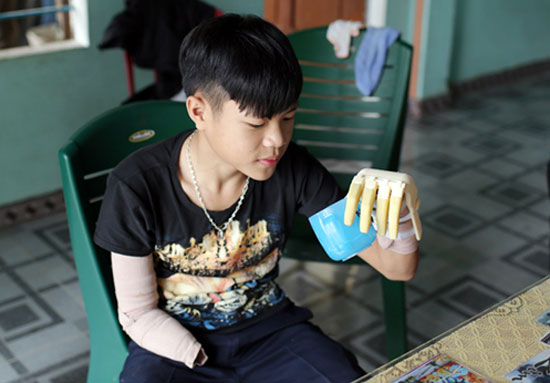Wonderful robotic arms benefit the disabled
The Robotica group from the Da Nang-based Duy Tan University (DTU) has already developed a meaningful project entitled ‘Robotic Arms for the Disabled’.
 |
| Hieu can hold a plastic glass with his robotic arm |
This project was initially inspired by how difficult and uncomfortable it is for the disabled who often partially or fully lost the use of an arm to do basic physical movement activities in their daily lives.
The Robotica team comprises seasoned and talented lecturers along with experts from the university. They are Dang Ngoc Sy, Dinh Huu Quang and Pham Quyen Anh, all from the Centre for Electricity and Electronics (CEE), plus Dr Ta Quoc Bao from the DTU’s Centre for Advanced Chemistry, and Ms Le Thi Thanh Thao from the university’s Silver Swallows Studio, who was the initiator of the idea.
The Robotica group has won many prestigious prizes at the national-level annual Robocon Viet Nam contests. In detail, the group won ‘The Best Manually Controlled Robot’ and ‘The Best Automatic Robot’ prizes in 2013, and one year later, they brought home the third prize and the “Best Style Award’. Thanks to their remarkable achievements, Robotica possesses a rich experience in creating robotic arms.
After 4 months of dedicated research and development, the group completed their meaningful project. In addition to such compulsory raw materials as plastic wires, non-stretch zippers, desiccant padding and highly durable Velcro, the DTU installed 2 plastic 3D printers and visible light communication technology.
The CEE also equipped with 2 plastic melting 3D printers to manufacture the detailed components with high accuracy.
In an effort to create an arm which is human like and as compliant as human limb, the Robotica group designed such components as fingers, hands, elbows, joints and muscles in 3D with the application of the Solidworks software, which was then sent to the 3D printer.
It took an average of 6 hours to print such a component, with some up to 15. To obtain the required precision, many trial printouts needed to be repeated several times. The group’s members also took the measurements of the recipients of the robotic arms for their prostheses, and then computed the structural forces corresponding to the length of the arms. Therefore, the robotic arms would be compact, lightweight, highly esthetic and useful in grasping objects of a various shapes, sizes and weights.
Two robotic arms were successfully attached to poor disabled teenagers, namely Phan Trong Hieu and Tran Dang Khoa, both from Quang Nam Province.
Tran Dang Khoa is a Year 6 pupil at the Nguyen Hue Junior High School in Dai Loc District. He has no left hand at birth, and this made the little boy fall into inferiority complex about his disability. Khoa’s parents are so poor that they couldn’t afford expensive prosthetics for their beloved son.
In a similar trouble, Hieu, an 8th grader at the Nguyen Trai Junior High School in Ai Nghia District, lost both hands after he had touched an unexploded bomb on a cattle ranch. This unexpected incident really shocked and deeply saddened his parents. His mother inventively made a tube of butter punched with holes to hold pens for him.
Initially, these boys both felt uncomfortable and awkward but, soon after having them fitted and especially encouraged by their families, the boys started to respond well to their artificial arms.
Thanks to robotic arms given by the Robotica group, both Hieu and Khoa now feel much happier with these valuable gifts as they can comfortably do their daily activities, including grasping objects, drinking and pouring water into glasses. In particular, Hieu is now able to ride his bicycle with his robotic arm.
The parents of the 2 boys feel very happy to see their beloved sons to confidently re-integrate into the community with their better lives.
Mr Sy, the CEE’s Vice-Director happily said that his group is now focusing on designing the Version No 3 of the robotic arms for disabled people. The main intention is to develop the 'Smart Arms' with intelligent sensors that can interpret signals from the central nervous system to control the muscles and execute movements, which should help the disabled overcome even more difficulties. The upgraded products will be attached to disabled people aged between 10 and 25.